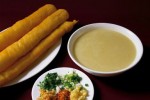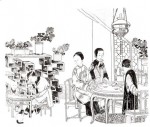Eating, the Chinese Way
China not only has a wide variety of cuisines and exotic fare in all its regions,  even ordinary homemade cooking for three meals a day can provide for plentiful unique recipes. The Chinese stress the aesthetics of food, the refinement of dining ware, and the elegance of dining environment, so having food is a daily enjoyment. Eating, as a branch of learning and art form, not only gave birth to rich and excellent culinary techniques, also reflects the Chinese’s content and joyful nature.
even ordinary homemade cooking for three meals a day can provide for plentiful unique recipes. The Chinese stress the aesthetics of food, the refinement of dining ware, and the elegance of dining environment, so having food is a daily enjoyment. Eating, as a branch of learning and art form, not only gave birth to rich and excellent culinary techniques, also reflects the Chinese’s content and joyful nature.
The Chinese have had a regular dining discipline since long ago. First it was a two-meals-a-day practice. The first meal, called zhao shi (morning food), is usually had around nine-o’clock in the morning. The second meal, bu shi, is had around four in the afternoon. The Chinese sage Confucius says that “bu shi bu shi,” which translates to “meals are not to be had if it is not the appropriate time,” meaning to emphasize the punctuality of meals. At around the Han Dynasty (206 B.C.-220 A.D.), with better development of agriculture, people of every nationality group and region slowly began to adopt the “breakfast, lunch and dinner” practice. Only their dinners were had much earlier than modern men, as they believed “work starts with the break of dawn and rest is to be taken when the sun goes down.” Three meals of the day must be prepared and eaten fresh, a way of showing the Chinese’s crave and love for food. In recent years, the pace of life for urban Chinese is getting faster and faster. Dining out is becoming more and more common, especially for lunch. Most office professionals dine at nearby restaurants, or in cafeterias of schools and work units. As for dinner, female heads of households are usually very attentive in its preparation.
In comparison with the Western way of individually served foods, the way of shared dining is seen as a distinguishable characteristic of the Chinese. For the Chinese, no matter if it is dining with family or with friends and  associates, people usually sit around the table and eat from the same served dish and the same bowl of soup. But this was not always the case, as ancient Chinese practiced individually served foods for quite some time before the switchover.
associates, people usually sit around the table and eat from the same served dish and the same bowl of soup. But this was not always the case, as ancient Chinese practiced individually served foods for quite some time before the switchover.
The earliest cooking and dining utensils were mostly earthenware placed on the ground. Later, supporting tools were invented, such as low, wooden tables. In the Shang Dynasty (around 17th to 11th centuries B.C.) oracle bone writings, one can see the character “su.” Its image is that of banquet seat (mat) with people sitting on it. The character “xi,” the pictograph of mat, shows that Chinese men at the time sat low on the ground. Most seating was rectangular or square in shape with the distinction of different sizes and lengths. The longer ones could seat several people while the shorter ones can seat at most two. The square ones were called du zuo (single seat), used by the elderly or people with high status. According to the needs, single or multi-tiered small mats can be set up. A person’s status can be observed from the number of people he or she is sitting next to. At the dining seats, a strict set of proprieties exists. Elders and younglings, or the noble and the vulgar, may not sit together. There exists factual occasions after someone has broken the proprieties, where the person who was dishonored wielded his sword to cut the seat into halves so as to end the inappropriate and humiliating seating situation. Corresponding to the seating customs, the Chinese also had a small table for each eater. The practice of individual seating and servings continued until the later years of the Han Dynasty (206 B.C.-220 A.D.). In Chengdu, Sichuan Province, uncovered from an Eastern Han Dynasty (25 B.C.-220 A.D.) tomb site were brick paintings with scenes of banqueting. People were shown to be sitting in groups of two or three, while tables lay in front. These paintings depict the lives of people during those times.
The ancient Chinese’s dining habit cannot be explained independently of their dining utensils. In the Tang Dynasty (618-907 A.D.), the former dining habits changed suddenly. Tall and long dining tables and chairs appeared. From the wall paintings at Dunhuang’s 473 caves, we can see illustrations depicting scenes inside a tent, where a long table sits, and tablecloth drapes from all four sides. We can see spoons, chopsticks, cups, plates and other dining utensils and vessels depicted on the table. Long seats are placed alongside the sides of the table, on them sits a number of men and women. Using high tables and large seats for dining gradually replaced the practice of seating on the ground. Sitting on round stools or high chairs around a table in a natural posture, while sharing a table full of tasty food, is the way the Chinese eat today; it is the most characteristic of the Chinese’s dining habits. It is safe to say that the emergence of shared dining and related customs is inseparable from and based on the changes in dining utensils and seating.
The idea of having families and friends enjoying great food at the table, for the Chinese, is full of warmth and harmonious atmosphere. This may be related to the close attention the Chinese pay to blood relationships and kinship. On another level, traditional Chinese culture focuses on “he,” or harmony. When dining together, it is an important way for the Chinese to have increased interpersonal understanding and communication. This may also be the reason behind the Chinese’s preference to chat vigorously at dining banquets. Epicures are concerned for individually served foods impacting the preservation of culinary aesthetics. For example, when a whole steamed fish, with great color, taste and aroma, is to be divided into individual servings, how shall it be divided? Who gets the head and who gets the tail? This certainly is a dilemma. It is no wonder that some epicure worry about China reverting to individual servings of food, afraid that it may result in a setback of a glorious culinary tradition, losing its certain unique advantages. In the face of the threat of SARS in 2003, whether or not to have individual food servings was an unprecedented topic actively debated by the government and the general public. For a time, forced implementation of individual servings took hold in restaurants. However, with the disease slowly being put under control, people regained their tradition of shared dining. In actuality, with the increased popularity of buffets, as well as  Chinese or Western fast foods, individually served foods have righteously entered the daily lives of urban Chinese. And with even more international communications, some upscale banquet shave universally adopted the practice of individual servings but with an atmosphere of shared dining.
Chinese or Western fast foods, individually served foods have righteously entered the daily lives of urban Chinese. And with even more international communications, some upscale banquet shave universally adopted the practice of individual servings but with an atmosphere of shared dining.
Regardless of shared or individual dining, the Chinese stress complementary servings of meats and non-meat dishes. Different foods such as cold, hot, salty or sweet items, each has its particular order for serving. An official dining occasion has specific ways of ordering and serving foods. In the past, at reasonably upscale restaurants, the first dishes to be served onto the table are usually four cold platters, usually meat appetizers, which go well with alcohol. If there were many drinkers, the number of appetizers would be increased to eight. Followed by four hot dishes, each being somewhat larger in serving compared to the cold platters. The hot dishes are usually made of fresh vegetables of the season, very appetizing but not oily. What comes afterwards are four mixed bowls, the dishes contain broth for both the purposes of maintaining temperature and being appetizing. Then finally come the real main courses; most are made with real delicacies found in the high mountains and the deep seas. Not only is the food tantalizing, cooking techniques and presentation put people in awe as well. The containers that hold the main courses are also unique. Large and deep bowls were often used in the past, and could have as many as four dishes. After the main courses come dry and moist desserts, rice and congee. The last to be served are soups and fruits. If one were having Yue (Cantonese) style food, the first to be served would be the soup. But for now, these “set rules” are only followed in formal banquets.